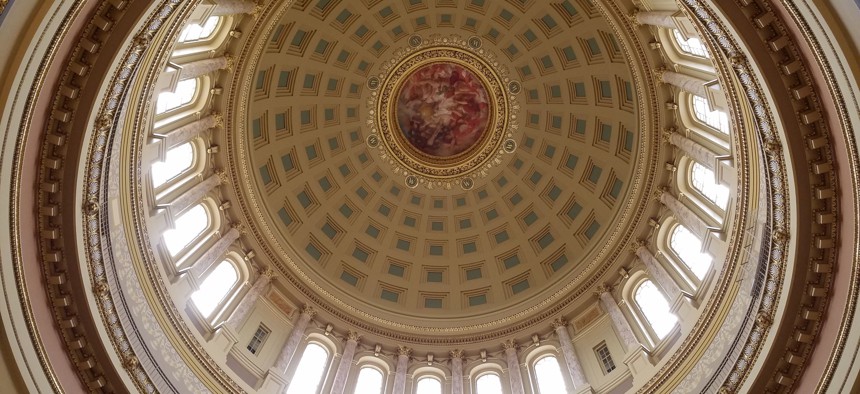Happy 100th Birthday, Wisconsin State Capitol

The Wisconsin State Capitol in Madison. Michael Grass / RouteFifty.com

Connecting state and local government leaders
PHOTOS: The Beaux-Arts building that dominates the Madison skyline came to be out of a mixture of disaster, bad luck and hubris—and it remains the Badger State’s most important public gathering point.
Six years ago, advocates of organized labor filled the Wisconsin State Capitol in protest of proposals being pushed by Republican Gov. Scott Walker to restrict the power of public sector unions in the Badger State.
While protests at official seats of power are certainly not unusual occurrences, the scenes coming out of the Beaux-Arts edifice in Madison were not from a run-of-the-mill public exercise in dissent. In a succession of protests, thousands of protesters, often on relatively short notice, filled multiple levels of the Wisconsin State Capitol’s Rotunda, the four wings that lead to it, plus various staircases and antechambers that connect the building’s various public spaces.
Although state Democrats and their allies in organized labor ultimately lost their fight against Walker and Republicans who control legislature, the images that came out of Madison in 2011 and after are powerful reminders of the symbolic importance of public spaces. In an era when citizens are too often disengaged from politics and policy, those moments when the public turns out to physically fill a public space stand out.

Those images from Madison are not all that dissimilar to those that have come out of major U.S. airport terminals—like JFK, LAX and SeaTac—in recent days where protesters have come to voice their opposition to President Trump’s executive order on immigration and refugees.
While airport terminals are designed to manage the flow of travelers, they aren’t necessarily built to accommodate mass protest. State capitols, however, were designed to be the “People’s House,” including the Wisconsin State Capitol, which is now 100 years old.
That centennial is being celebrated in Madison this month.
Last year, I visited Madison and toured Wisconsin’s beautiful seat of government, from the governor’s conference room, state Supreme Court chamber, legislative chambers and the Rotunda. It’s a stunning building.

There’s no doubt about it that the Wisconsin State Capitol is among the most architecturally impressive seats of government in the United States. As I wrote last year during a visit to Madison, the origins of the current Wisconsin State Capitol came are rooted in disaster, bad luck and a bit of hubris thanks to a fire that destroyed the previous building.
Despite all that, the current iteration of the building has now stood the test for a century, all under the view of the massive mosaic personifications of the three branches of government, plus “Liberty” that dominate the Rotunda’s massive vaults.

“I see the dome as a beacon of hope, and I think that at the heart there is good in that building,” one observer recently told the Wisconsin State Journal. “I don’t consider those who protest negatively, either. They are passionate people who want to make change and want to be heard.”
And the Wisconsin State Capitol, and other public buildings just like it, are important settings where to do just that.
PREVIOUSLY on Route Fifty:
Michael Grass is Executive Editor of Government Executive’s Route Fifty and is based in Seattle.

NEXT STORY: Trump to Meet With U.S. Governors in February





